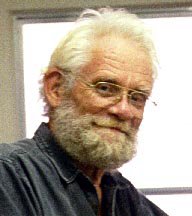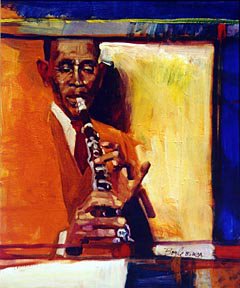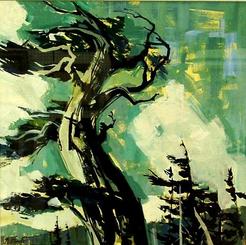
Morgan studied art at an early age with his father, a former art student. His parents both met at art school. His father, Howard, a POW in Germany, entertained his fellow American prisoners in Stalag 1 with a daily comic strip that he created and drew to keep morale up. Drawn on scraps of paper found on the prison grounds, he crafted a humorous world of characters that managed to bring a smile to imprisoned soldiers. In the last days of the war and feeling the Russians would be coming, his talents with painting saved his life. Using some paints supplied by the Geneva Convention, he painted a American Flag on the shoulder of his prisoner uniform so that the Russians invading Germany would identify him and not shoot him. It worked.
Weistling's father came back from the war with dreams of being an artist. With the G.I. Bill, he took classes at Woodbury Art College in Los Angeles where he met Morgan's mom. After marrying and starting a family, Morgan's father had to abandon his artistic dreams and support his new family by becoming a gardener. But, he saved all his art books....
Morgan, much younger than his brother and sister, began his artistic training as early as 19 months old. His father would sit with him on his lap at night and teach him how to draw and use his imagination. " My dad and I bonded together with drawing and spoke to each other with pictures". Weistling's father had a real talent for telling a story in comic strip form and so it began in Morgan, a natural sense of the narrative."It was here that art became a language for me."
That led to his studying the art books his father had acquired years earlier. Authors such as Andrew Loomis, Vanderpole, and Bridgeman. The most important books, though, were the volume set from the Famous Artist School.
At the age of 12, Weistling was determined to go through the entire course on his own since the school was no longer in existence. By the age of 15, his study of anatomy, drawing, and painting needed a mentor's direction.
That direction came through a retired illustrator named Fred Fixler. Fred's school, then called the Brandes Art Institute, was dedicated to one thing: learning how to draw from life. "The minute I saw his life drawings I knew this was the guy to study with, there was no doubt," says Morgan. Working part-time as a janitor for the school to pay his tuition, Weistling studied there for 3 years.

While still a student and working at an art store, one day a prominent illustrator came in for supplies. Weistling showed him his student work. The next day he found himself employed at one of the top movie poster agencies in Hollywood. "At that time, all I wanted to be was an illustrator," Weistling says, "but that was amazingly fast." For the next 14 years he illustrated for every movie studio in Hollywood as well as many other fields of illustration.
After being art-directed for years, Morgan needed to paint something for himself. He took time out to produce a painting of two children and brought it to Scottsdale Arizona on the advice of long time friend, Julio Pro .
The first gallery he walked into signed him on the spot, Trailside Galleries. Co-owner Maryvonne Leshe was quick to spot new talent. She was soon proven right. "He would send his paintings to us un-framed and before we could get them hung, they would be sold," quips Maryvonne. Soon a "draw" system for Weistling's paintings became necessary. His first one-man show had 26 paintings and all were sold opening night. Since then, Morgan has had four more one-man shows and they sold -out opening night as well.
Also interested in depicting his Christian faith, Morgan has portrayed the life of Christ in many of his paintings. Those images can be found in the best selling book, The Image of Christ, with paintings and text by Morgan.
Greenwich Workshop publishes his paintings as giclee canvases.
Morgan and his wife, JoAnn, have been married 14 years and also met in art school. JoAnn is a painter too. She paints under the name, J.Peralta, to honor her grandmother. Their 9 year old daughter, Brittany, is often a model in Weistling' paintings.
Visit Morgan's
website
 While the name John Berkey may not be as well known as Norman Rockwell, Berkey is arguably as famous. His spaceship illustrations helped influence Star Wars, as he was commissioned by director George Lucas to do pre-production designs for the first movie in the series.
While the name John Berkey may not be as well known as Norman Rockwell, Berkey is arguably as famous. His spaceship illustrations helped influence Star Wars, as he was commissioned by director George Lucas to do pre-production designs for the first movie in the series. Berkey was commissioned to paint one of two images the United States Postal Service considered in honoring Elvis Presley with a 29-cent stamp. In April 1992 the Postal Service let customers vote on which image of Elvis they preferred to see on a postage stamp: the young crooner or the older, jumpsuit-wearing lounge singer. Berkey was commissioned to paint the older version of Elvis, but the voting public preferred the younger version by a margin of about 3-to-1. The younger version of Elvis, singing into a microphone in front of a pink background, made its debut in January 1993.
Berkey was commissioned to paint one of two images the United States Postal Service considered in honoring Elvis Presley with a 29-cent stamp. In April 1992 the Postal Service let customers vote on which image of Elvis they preferred to see on a postage stamp: the young crooner or the older, jumpsuit-wearing lounge singer. Berkey was commissioned to paint the older version of Elvis, but the voting public preferred the younger version by a margin of about 3-to-1. The younger version of Elvis, singing into a microphone in front of a pink background, made its debut in January 1993.



































